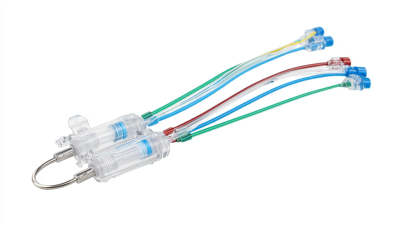What is an Aln Filter and How Does It Work in Modern Applications
In the rapidly evolving landscape of modern technology, the role of advanced filtering solutions has become increasingly pivotal. Among these, the aln filter stands out due to its exceptional performance characteristics and broad applicability across various industries. According to a recent report by MarketsandMarkets, the global filter market is projected to reach USD 124.9 billion by 2025, with a significant surge in demand for sophisticated filtering technologies like the aln filter, particularly in sectors such as telecommunications and aerospace.
The aln filter operates on the principles of precision and efficiency, enabling the attenuation of unwanted frequencies while preserving the integrity of desired signals. This is increasingly crucial in applications ranging from high-frequency communication systems to medical devices, where signal clarity directly impacts performance and outcomes. As the need for high-speed data transfer and actuation grows, so does the importance of adopting advanced filtering solutions like the aln filter, which not only enhances system reliability but also optimizes operational efficiency.
As we look towards 2025 and beyond, the integration of aln filters in modern applications reflects a broader trend towards miniaturization and sophistication in electronic components. With experts predicting a compound annual growth rate (CAGR) of 6.1% for the global advanced filtering market, understanding the functionality and advantages of aln filters will be crucial for industry leaders aiming to maintain a competitive edge in a technology-driven world.

Understanding the Basics of Aln Filters in Modern Technology
An AlN (Aluminum Nitride) filter is an advanced component typically used in high-frequency applications, taking advantage of its exceptional properties. Understanding the basics of AlN filters involves grasping their material composition and how they function within electronic systems. AlN exhibits a unique combination of high thermal conductivity and excellent dielectric properties, making it particularly suited for RF and microwave applications. According to a 2022 market report by Research and Markets, the demand for aluminum nitride components in the electronics sector has surged, with projections indicating a growth rate of over 15% annually.
In modern technology, AlN filters play a significant role in telecommunications and power electronics. Their ability to operate efficiently at elevated frequencies makes them ideal for use in 5G networks and satellite communications. The latest data from the International Journal of Applied Ceramic Technology highlights that AlN-based filters can achieve insertion loss levels as low as 1 dB, significantly outperforming traditional filtering materials. This performance is critical in reducing signal degradation and ensuring clearer communication, thereby enhancing the overall efficiency and reliability of modern electronic devices.

Key Applications of Aln Filters in Various Industries
AlN filters, or Aluminum Nitride filters, have emerged as crucial components in various industries due to their unique properties and efficiency in signal processing. One of the primary applications of AlN filters lies in the telecommunications sector, where they facilitate the filtering of high-frequency signals. These filters help improve signal integrity and enhance data transmission rates in wireless communication systems, making them indispensable for 5G networks and beyond.
In addition to telecommunications, AlN filters are increasingly utilized in consumer electronics, such as smartphones and tablets. Their capability to minimize interference ensures that devices operate smoothly, delivering a better user experience. Furthermore, the automotive industry benefits from AlN filters as they are employed in radar systems for collision avoidance and advanced driver assistance systems (ADAS). By enabling precise signal separation, AlN filters contribute to safer and more reliable vehicle technology. Overall, the versatility of AlN filters positions them as vital components across multiple sectors, driving innovation and efficiency in modern applications.
Key Applications of AlN Filters in Various Industries
This chart illustrates the percentage of usage of AlN filters across different industries, showcasing their importance in modern applications.
How Aln Filters Enhance Signal Processing and Data Transmission
Aln filters have emerged as a pivotal technology in advancing signal processing and data transmission, particularly in high-frequency applications. These filters utilize aluminum nitride (AlN) as a substrate, which boasts exceptional piezoelectric properties and thermal conductivity, enabling them to operate efficiently across a broad frequency range. According to a report by MarketsandMarkets, the global market for advanced filters is expected to reach $15 billion by 2025, driven largely by the increasing demand for high-speed data communication and wireless technologies.
The enhancement in signal clarity provided by AlN filters significantly reduces noise and interference, ensuring that data transmission remains reliable and efficient. For instance, the insertion losses in AlN-based filters can be as low as 0.5 dB at frequencies over 6 GHz, as stated in a study by the International Journal of Electronics. This reduction in signal distortion is crucial for applications such as 5G networks and IoT devices, where data integrity is paramount. Furthermore, the miniaturization of AlN filters allows for compact device designs, enabling seamless integration into modern electronic systems.
Comparison of Aln Filters with Traditional Filter Technologies
In modern applications, AlN (Aluminum Nitride) filters are often compared to traditional filter technologies like silica and ceramic filters. One notable difference is the material properties; AlN exhibits superior thermal conductivity and a wide bandgap, making it extremely efficient for high-frequency applications. This allows AlN filters to operate effectively in environments that require reliable performance under varying thermal conditions, unlike traditional filters that may suffer from performance degradation at high temperatures.
Additionally, AlN filters are characterized by their compact size and lightweight nature, which presents advantages in designing modern electronic devices where space and weight are critical factors. Traditional filters, such as ceramic filters, tend to be bulkier and heavier, limiting their application in portable electronics and converging technologies. The enhanced durability and mechanical strength of AlN contribute to its growing use in demanding environments like automotive and aerospace industries, where reliability and efficiency are paramount.
This shift towards AlN technology signifies a broader trend of adopting advanced materials that provide better performance and integration capabilities compared to conventional filtering solutions.
Future Trends and Innovations in Aln Filter Development
The evolution of AlN filters continues to push the boundaries of modern technology, enabling advancements across various fields. Emerging trends indicate a shift towards integrating AlN filters into next-generation communication systems, particularly in 5G and beyond. These filters are not only favored for their excellent frequency selectivity and thermal stability but also for their ability to effectively minimize signal interference, which is crucial in densely populated urban environments where multiple signals converge. As demand for high-speed data access rises, the innovation surrounding AlN technology will likely lead to the development of devices that further enhance signal clarity and network efficiency.

Additionally, research is delving into the miniaturization of AlN filters. The push for smaller, more efficient components can significantly impact consumer electronics, automotive systems, and portable devices. Innovations in fabrication techniques, such as micro-electromechanical systems (MEMS) and advanced layering methods, are paving the way for AlN filters that are not only compact but also cost-effective. As these filters become more integrated into multifunctional devices, the focus on sustainability and environmental impact will also drive future innovations, leading to greener manufacturing processes and recyclable materials in the production of AlN filters. This transformative phase is setting the stage for the next wave of technological advancements.
Related Posts
-

2025 Top 5 Arrow Arterial Line Kits for Enhanced Patient Care and Safety
-

Top 10 Control Syringes for Precise Dosage and Optimal Performance
-

Understanding the Importance of Luer Stopcocks in Fluid Management Systems for Healthcare Efficiency
-

Essential Guide to Choosing the Right Catheter Drainage Bag for Optimal Comfort and Care
-

Understanding the Importance of Catheter Fixation Devices in Modern Healthcare
-
Understanding the Science Behind Luer Lock Stopcocks: Essential Guide for Medical Professionals
